Objective Considerations In Promoting A Socialization Competence At The Fundamental Acquisition Cycle
Abstract
From the moment of introduction and till now, the preparatory grade from the fundamental acquisition cycle has accumulated a seniority that offers a well defined status and that requires a special attention. Researching and analysing the maintenance of the interactive flow of kindergarten children and until the ending of the fundamental acquisition cycle, it is registered a high percentage of the continuity of their interaction from an educational environment to another. The presence of a socialization competence raises the bar both at a methodological level, but especially to a practical level, the more as this socialization interactive flow exists in the preschool educational activity and it is also maintained in a consistent proportion in the education activity of fundamental acquisitions. Even more, the results of the inquiry conducted by us among the teachers, emphasizes the fact that a significant part of the specialists in the field of physical education appreciate the role and the benefice influence the physical education lesson has at the level of fundamental acquisitions cycle. Recent studies conducted nationally and internationally, emphasize that the physical education lesson at this level still lacks its capacity to form and improve interpersonal relations and group cohesion. But these researches also emphasize the fact that through physical activity, its operating forms, the socialization level of children, increases, evolves and adapts to new requirements for the surrounding reality, being a live, active and interactive process.
Keywords: Interactionformal framepromotion
Introduction
For each child, the passage from kindergarten to school also includes his transition from an activity predominant for the preschool period, to an activity predominant for the characteristics of small school age. The prevailing activity for the kindergarten period, namely the game, is slowly replaced with learning elements. Therefore, learning is present in the activity conducted in the process of scholar learning, having the role to satisfy the interest, curiosity and adaptability of the child for knowledge (Domide, 2012, para 6-7).
“The connection of kindergarten with school has a double sense, the purpose of this connection being the continuity of the child’s development and continuity of the educational process. So that the transition from kindergarten to school to be natural, the educators and schoolmasters’ activity should combine; each of the two factors should have a common element under the aspect of the teacher-student relation, the powerful affective tone that characterises the educator should combine with the more authoritarian pregnant relation characteristic for the schoolmaster” (Pleșcan, 2012, paragraph 20-21).
Kindergarten environment, similar to the school, forms the student, little by little, so that the scholar education period totally modified the regime, tension and plan of events that prevail in the child’s life. “Continuous assimilation of newer knowledge, especially the responsibility towards their assimilation quality, situation of collaboration and competition, obvious character of the rules involved in the scholar life contribute to modification on an existential background of the little schoolboy” (Șchiopu & Verza, 1981, p.133-134).
School symbolizes a transition passage between family and society, that is tasked to continue and correct the effects of micro-socialization (the basic 6 first years of the education), generating acquisitions in socialization plan, with the purpose to prepare the young for post-school approach, that moment when they take major decisions regarding their public life (choosing a faculty, future profession-career, political behaviour) and private life (starting a family, relations with friends, becoming a parent). (Rîșnoveanu, 2010, p.17).
School education, as formal activity conducted and planned on the institutional level, is at the same time cause and effect. Along with the school activity, also takes place the child’s pshychical growth, that makes him fit for some social and intellectual disciplines. School has the role to polish the physical, intellectual and social conduct of the student. (Debesse, 1970).
“School represents for the child a life and work frame in which the requirement forms condition the expression of some of the most different abilities or behaviours” (Holban & Gugiuman, 1972, p.18).
“School represents a space of learning, experiment, right to try and fail, of individuals’ «growth», of the multiple possibilities offered to students in the conditions of a social and psychological comfort by the adults’ universe” (Rîșnoveanu, 2010, p.18).
These days the scholar learning process is based on competences. This educational goal is proposing to “solve scholar and different socio-economical needs, such as: relevance of training, access on the international market of education and professional career, compatibility and transfer of the training programs and their results, recognition of studies in other countries” (Chiș, 2005, p.136). Present in economy, as well as in school, the priority of competence has increased due to the socio-professional reasons and affirmation of personality, more precise the evolutionary process of the society has brought in the spotlight the concept of competence (Joița, 2010).
The concept of competence shows another type of learning results, as part of the area that comprises the means, set in the place of a new reference system (Cucoș, 2006). The concept of competence give an evolution note regarding the educational means, recording through time an entire process of transformations: knowledge – training-educational means – objectives – competences (Ardelean & Mândruț, 2012).
“Competence does not requre only the efficient execution of the given task, but also creativity, initiative, autonomy, invention, openness to deal with the more and more complex, problematic reality” (Joița E., 2010, p.59). Competent is that student who “proves himself skilful to fulfil a task, proving what he knows and especially what he is able to do” (Albulescu & Albulescu, 2002, p.28).
Within the primary education these educational means are divided into two categories: general competences – promoting the knowledge transfer; specific competences – postulating knowledge acquiring (Frumos, 2008, pp.130-131).
Education general competences, according to the autor Cucoș Constantin, are delimited as “structured ensembles of knowledge and skills acquired through learning; these appear as operating structures with the help of which they can be identified and solved, in different contexts, characteristic problems of a certain field” (Cucoș 2006, p.202). Specific competences derive from the general competences and represent stages in their acquirement, having the role to customize the general ones (Physical education curriculum – preparatory grade, Ist and IInd grade, 2013, p.2).
Centring education on competences targets the correction of young’s abilities concerning their integration in the practices specific to the fields of activities present in the society, by placing them regularly and gradually in situations, moments, points more and more complex, in which they have the opportunity to exploit the result of their learning, to experiment everything they acquire (Rogiers, 2005).
Problem Statement
From the analysis of the three studies conducted based on our idea to promote and implement a socialization competence at the fundamental acquisitions cycle, within the primary education, there are pointed out a series of objectives that favour the beginning of our project to introduce such competences. The necessity to form and include a social competence at this age level is firstly accepted by the teachers/field specialists that appreciate the role and benefice influence of the physical education lesson on the development of interpersonal relations and group cohesion. Secondly, the considerable level of the interactive flow that is maintained in children’s transition from the preschool education - preparatory grade, Ist and IInd grade of the fundamental acquisitions cycle, promote the development of this project. Thirdly, the result of the scientific research in which the socialization process of children is formed and developed through motor activities/physical activities not integrated into a formal frame, ensures the practical support and strengthens the projection of this competence specific to the primary cycle of fundamental acquisitions.
Research Questions
For a rigorous orientation of the research approach I have formulated the following questions, for which we would like to offer argued answers:
•To which extent do the specialists appreciate the introduction of a specific socialization competence that guides correctly and efficiently the process of students’ social integration of the students in the fundamental acquisition cycle, through scholar physical education lesson?
•Which is, on average, in Arges county (or where) the percentage where children pass from the same upper preschool group from kindergarten to the preparatory grade in the same school?
•Are there or aren’t there opportunities of children’s personal development in which the physical activity/motor activity eases the social integration process of students form the curricula cycle of fundamental acquisitions? Which would be the objective arguments to sustain this?
Purpose of the Study
Purpose of this study is to identify the solid arguments, practical for the introduction of specific competences, at the level of the curricula cycle of fundamental acquisitions, in the direction of social integration of children and to establish to what extent this will be able to sustain a project of promotion, elaboration, implementation and formation of the socialization competence at this level in order to form a proper behaviour within the class, to cultivate interpersonal relations and to accomplish, in time, the group’s cohesion, as social attitudes.
Research Methods
In order to further elaborate this research, I have analysed a set of research methods:
•Documentation method/bibliographical study in order to identify those studies and researches that emphasize the role and contribution of the physical activities/motor activities, characteristic to children of six-nine years of age, with influences in cultivation, development and improvement of interpersonal relations and group’s cohesion;
•Investigation method based on questionnaires, used to find out the specialits’ opinions regarding the idea of implementing and forming of socialization competence at this curricular cycle;
•Static method used to analyse and interpret the results of the investigation and the interactive flow of kindergarten children up to the end of fundamental acquisitions cycle.
Findings
Analysis and interpretation of results of the questionnaire among teachers/specialists in physical education field
In order to identify the opinion of teachers/specialists in physical education field regarding the researched aspect, I have elaborated a mix questionnaire, structured on ten items that I distributed to a number of twenty teachers/specialists in physical education field of the physical education field. They had the courtesy to answer us twenty teachers/specialists in physical education field.
The opinions of the teachers are not very different, most of them sustain and also consider that the activity within the physical education lesson, besides the recognized contribution on physical condition and posture, may evolve, making its mark on other chapter, acting as an active process on social interaction.
The utility of the questionnaire (Figure
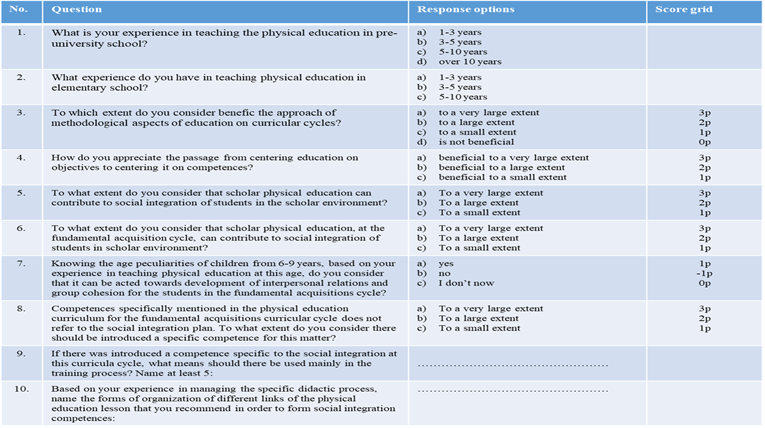
Following the analysis Alpha Cronbach, the coefficient of the questionnaire was of 0,645133. Although the coefficient obtained does not have a considerable consistency, this being classified as being “acceptable”, some authors draw the attention that a value of minimum 0.5 of the Alpha-Cronbach index is considered acceptable for the questionnaires with a number of 10-15 items, while the questionnaires with a number higher than 50 items must have a value of at least 0.8. Thus, taking into consideration all these information, we can say about our questionnaire that the value obtained is more than “acceptable”, also due to the fact that of the ten questions of the questionnaire, only six of them were and could have been analyzed with the help of the Alpha-Cronbach index.
The remaining questions were analyzed though another perspective. Thus from the first two questions, item no. 1 and item no. 2, as result of the examination, resulted that the richer didactic experience facilitates considerations that support and sustain hereinafter the research approach proposed. The majority of the specialists embrace this methodological step regarding the addition of a specific competence in the students’ social integration plan, through scholar physical education discipline.
The last two questions of the questionnaire, items 9 and 10 respectively, are open questions that allow the respondents to formulate freely the answer, form a personal perspective (Figure
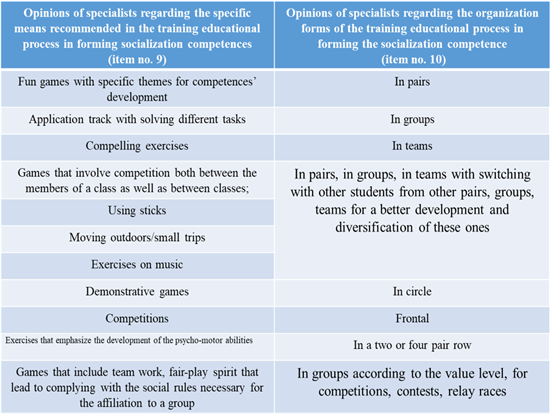
Considering this information, as well as the acceptability degree of the other items analyzed through the Alpha Cronbach coefficient, we can state that the internal consistence degree of the questionnaire becomes even more precise and accurate to the purpose of the research.
Although the analysis of this questionnaire also required a more complex examination, regarded from multiple angles, the results of its application succeded to emphasize the essential aspects that strengthen and support the socialization competence and our desire to introduce it in the educational process of the primary education;
Analysis and interpretation of results regarding the maintenance of the interactive socialization flow of kindergarten children and up to the primary cycle of fundamental acquisitions
The research started shows that a large part of the children with the same group from the preschool education are also found in the groups of the primary cycle of fundamental acquisitions of education.
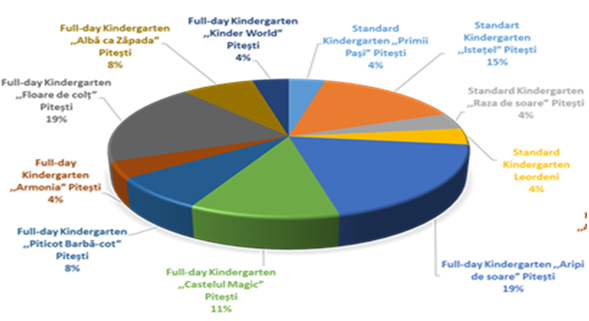
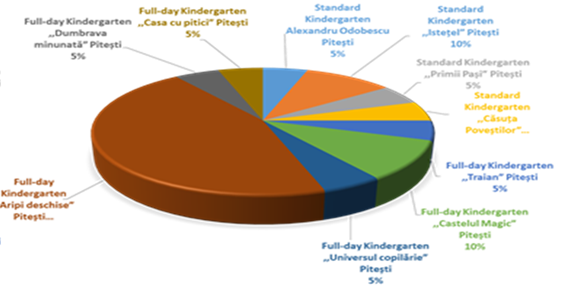
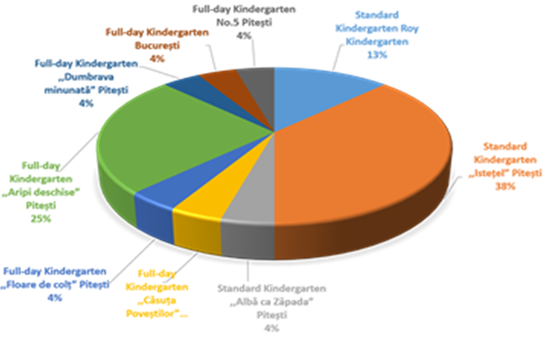
The proportions registered in Figure
It must be specified that some preschool units that were presented have a governmental state, while the others preschool units are private. No matter the nature of the preschool education, private or governmental, this interactive socialization flow has a linear process, an ascendant development, that allows and at the same time complies to an involvement on the continuous development of this essential aspect of the children’s behaviour.
Study regarding the scientific research magazine regarding the formation of interpersonal relations and group cohesion at the age of six-nine years
Researches such as ”The importance and utility of the sociometrical survey method in physical education research”, by authors Sopa Ioan Sabin, Sanislav Mihai, Marcel Pomohaci and ”Psychological characteristics specific to interpersonal relations at preschool children” by Elena Rukavishnikova” include physical activity/physical motion in the process regarding the stimulation of interpersonal relations and group cohesion. But this physical activity/physical movement has for now an informal character, not characteristic to the process of educational scholar education.
The first study emphasizes the utility of the sociometric method in a sporting environment, the football team of a school unit. This can draw essential information regarding the group’s environment state and also can offer the necessary support to improve its interaction through motor/physical activity (Sopa, Sanislav, & Pomohaci, 2013).
The second study confirms a reciprocity regarding the role of communication in creating an emotional climate favorable in the games groups, but also the game activity contributes to the formation of selective affections between children. In the game activity there occur interpersonal relations and takes place a communication that regulates the transaction of the game situation, thus maintaining an emotional atmosphere – common for all participants (Rukavishnikova, 2016).
Conclusion
1.The activity of the physical education lesson benefits from the informational support, as well as the practical from the teachers/field specialists, in achieving the act of introducing a socialization competence specific to the primary cycle of fundamental acquisitions. The coherence of the physical education lesson and the social competence is confirmed by the teachers’ whose activity is conducted at the level of this curricular level, that support and desire a bio-psycho-social development of the students present in this educational stage through strategies specific to physical education and sports discipline.
2.The social contact of children who pass to the same upper preschool group from kindergarten in the same school unit in the preparatory grade is maintained in a consistent proportion, which facilitates the approach of the social interaction process. Both in Arges County as well as outside it, the percentage of the students that pass from the upper preschool group to the preparatory grade is enough to continue the socialization process that started even from the preschool environment.
3.As for the existence or not of some personal development gaps of children, in which the motor activity eases the social integration process of students in the curricular cycle of fundamental acquisitions, these are non-existant in great part due to the generalization of the upper preschool group in the form of preparatory grade in the primary education.
Scientific research that approach the social interaction issue of children of six-nine years of age, raise the physical movement not institutionalised. But this particular thing, the fact that physical movement without a formal character contributes to the development of the interpersonal relations, such as group cohesion, represents a solid and real argument that helps the idea of our project to promote, implement and form a socialization competence.
Acknowledgments
At the end of this presentation, I would like to thank the teachers who had the courtesy to answer to our questionnaire, who expressed their opinions openly regarding the issue raised, and also the schoolmasters who agreed to participate to our research, offering us the informations necessary to identify and localizing the kindergartens previously frequented by each student, from every class of the curricular cycle of fundamental acquisitions.
References
- Albulescu, M. & Albulescu, I., (2002). Study of socio-human disciplines. Formative aspects: structure and competences’ development.Cluj Napoca: Dacia Publishing.
- Ardelean, A. & Mândruț, O., (2012). Didactic of competences formation. Retrieved from http://www.uvvg.ro/cdep/wp-content/uploads/2012/06/Didactica-competente-final.pdf at 24.09.2018.
- Chiș, V., (2005). Contemporary pedagogy- pedagogy for competences. Cluj Napoca: Science Book House Publishing.
- Cucoș, C., (2006). Pedagogy – IInd edition revised and added, Bucharest: Polirom Publishing,
- Debesse, M., (1970). Child’s Psichology – from birth to teenage years. Bucharest: Didactic and Pedagogic Publishing.
- Domide, A., (2012). Continuity-Kindergarten-Shcool, Continuity between kindergarten and school in preparing preschoolars in acquiring Mathematics. Retrieved from http://pipp-bn.blogspot.com/2012/02/continuitate-gradinita-scoala.html, at 24.09.2018, 21.53 hours
- Frumos, F., (2008). Didactic – Fundaments and cognitive developments. Bucharest: Polirom Publishing.
- Holban, I. & Gugiuman A., (1972). Supportive points in knowing the students’ individualities. Bucharest: Didactic and Pedagogic Publishing.
- Joița, E., (2010). Metodology of education – Changes in paradigms. Iași: European Institute Publishing.
- Pleșcan, I. R., (2012). Continuity-Kindergarten-Shcool, Importance of continuity between kindergarten and school on Ist grade. Retrieved from http://pipp-bn.blogspot.com/2012/02/continuitate-gradinita-scoala.html, at 24.09.2018.
- Physical education curriculum – preparatory grade, Ist grade and IInd grade, (2013), http://programe.ise.ro/Actuale/Programeinvigoare.aspx, accessed at 18.09.2018, 23.44 hours:
- Rîșnoveanu, A., (2010). School – Socialization agent. Theories, particularities, practices. Bucharest: University Publishing.
- Roegiers, X., (2005). L’évaluation selon la pédagogie de l’intégration - Est-il possible d’évaluer les compétences des élèves?, Retrieved from http://www.bief.be/docs/publications/evaluation_des_competences_070220.pdf, accessed at 26.09.2018,
- Rukavishnikova, E., (2016). Specific Psychological Characteristics of Interpersonal Relationships in Preschool Children, Retrieved from https://www.sciencedirect.com/, at 07.05.2018
- Sopa, I., Sanislav, M., Pomohaci, M., (2013). The Importance and Utility of the Sociometric Survey Method in Physical Education Research, accessed Retrieved from https://www.sciencedirect.com/, at 09.06.2018
- Șchiopu U. & Verza E., (1981). Psihology of ages – live cycles. Bucharest: Didactic and Pedagogic Publishing.
Copyright information

This work is licensed under a Creative Commons Attribution-NonCommercial-NoDerivatives 4.0 International License.
About this article
Publication Date
15 August 2019
Article Doi
eBook ISBN
978-1-80296-066-2
Publisher
Future Academy
Volume
67
Print ISBN (optional)
-
Edition Number
1st Edition
Pages
1-2235
Subjects
Educational strategies,teacher education, educational policy, organization of education, management of education, teacher training
Cite this article as:
Gabriel*, T., & Mihăilescu, L. (2019). Objective Considerations In Promoting A Socialization Competence At The Fundamental Acquisition Cycle. In E. Soare, & C. Langa (Eds.), Education Facing Contemporary World Issues, vol 67. European Proceedings of Social and Behavioural Sciences (pp. 1805-1814). Future Academy. https://doi.org/10.15405/epsbs.2019.08.03.222
